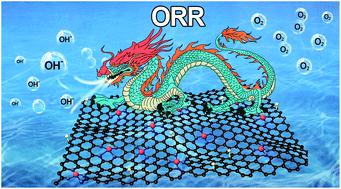当前位置:
X-MOL 学术
›
J. Mater. Chem. A
›
论文详情
Our official English website, www.x-mol.net, welcomes your feedback! (Note: you will need to create a separate account there.)
A superior electrocatalyst toward the oxygen reduction reaction obtained by atomically dispersing copper on N, F co-doped graphene through atomic interface engineering
Journal of Materials Chemistry A ( IF 11.9 ) Pub Date : 2022-05-31 , DOI: 10.1039/d2ta01990f Jing-Ping Zhong 1, 2 , Cheng Hou 1 , Miao-Lan Sun 1, 3 , Zhong-Yun Yang 1 , Du-Hong Chen 1 , You-Jun Fan 1 , Wei Chen 1 , Hong-Gang Liao 3 , Shi-Gang Sun 3
Journal of Materials Chemistry A ( IF 11.9 ) Pub Date : 2022-05-31 , DOI: 10.1039/d2ta01990f Jing-Ping Zhong 1, 2 , Cheng Hou 1 , Miao-Lan Sun 1, 3 , Zhong-Yun Yang 1 , Du-Hong Chen 1 , You-Jun Fan 1 , Wei Chen 1 , Hong-Gang Liao 3 , Shi-Gang Sun 3
Affiliation

|
Single-atom catalysts, featuring 100% metal atom utilization, strong metal–support interaction, low coordination environment, and high selectivity, have attracted great attention towards the enhancement of the oxygen reduction reaction (ORR). In the current work, we propose an atomic interface strategy for the construction of Cu single-atom catalysts dispersed on N, F co-doped graphene (Cu SA-NFG). The Cu SA-NFG catalyst exhibited excellent ORR activity in alkaline media. Both X-ray absorption fine structure and density functional theory results demonstrated that the Cu–N4 atomic interface is the active site for the ORR, and the electron-withdrawing F atoms can decrease the Gibbs free energy for the adsorption of intermediates. In addition, the Pt nanoparticle-decorated Cu SA-NFG catalyst displayed superior catalytic performance toward methanol oxidation. This work provides a new method for the rational design of advanced electrode materials and a new guide for the improvement of catalytic performance toward direct methanol fuel cells.
中文翻译:

通过原子界面工程将铜原子分散在 N、F 共掺杂石墨烯上获得的氧还原反应的优异电催化剂
单原子催化剂具有100%金属原子利用率、强金属-载体相互作用、低配位环境和高选择性等特点,在增强氧还原反应(ORR)方面引起了广泛关注。在目前的工作中,我们提出了一种原子界面策略,用于构建分散在 N、F 共掺杂石墨烯 (Cu SA-NFG) 上的 Cu 单原子催化剂。Cu SA-NFG催化剂在碱性介质中表现出优异的ORR活性。X 射线吸收精细结构和密度泛函理论结果表明,Cu-N 4原子界面是ORR的活性位点,吸电子F原子可以降低中间体吸附的吉布斯自由能。此外,Pt 纳米颗粒修饰的 Cu SA-NFG 催化剂对甲醇氧化表现出优异的催化性能。该工作为先进电极材料的合理设计提供了新方法,为直接甲醇燃料电池催化性能的提高提供了新的指导。
更新日期:2022-05-31
中文翻译:

通过原子界面工程将铜原子分散在 N、F 共掺杂石墨烯上获得的氧还原反应的优异电催化剂
单原子催化剂具有100%金属原子利用率、强金属-载体相互作用、低配位环境和高选择性等特点,在增强氧还原反应(ORR)方面引起了广泛关注。在目前的工作中,我们提出了一种原子界面策略,用于构建分散在 N、F 共掺杂石墨烯 (Cu SA-NFG) 上的 Cu 单原子催化剂。Cu SA-NFG催化剂在碱性介质中表现出优异的ORR活性。X 射线吸收精细结构和密度泛函理论结果表明,Cu-N 4原子界面是ORR的活性位点,吸电子F原子可以降低中间体吸附的吉布斯自由能。此外,Pt 纳米颗粒修饰的 Cu SA-NFG 催化剂对甲醇氧化表现出优异的催化性能。该工作为先进电极材料的合理设计提供了新方法,为直接甲醇燃料电池催化性能的提高提供了新的指导。



























 京公网安备 11010802027423号
京公网安备 11010802027423号